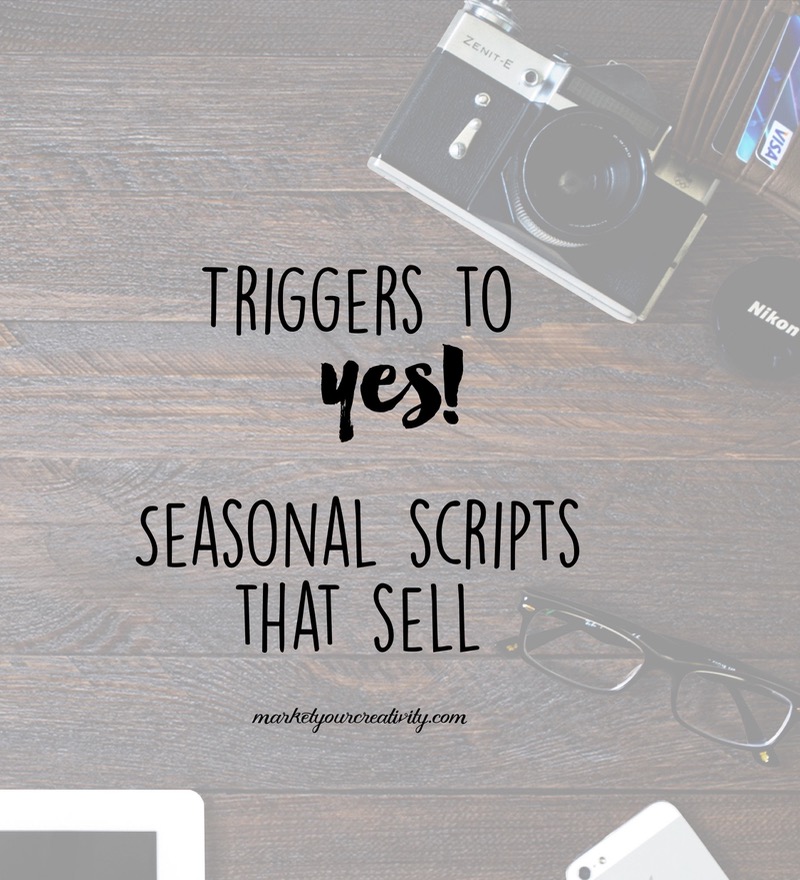Let’s talk seasonal scripts that sell; I want to show you how to write in a way that gets more customers saying “YES!” to your offers.
If you were able to catch my Copywriting for Crafters class on CreativeLive, you’ll know that every time you write to your customers online, that writing falls into one of two categories: content marketing or copywriting. (From that link, watch the free preview of the class for an excellent breakdown of this topic.)
Both forms of writing should be done with purpose and an end-result in mind while maintaining a conversational and casual tone. Most sellers aren’t well-rehearsed in this type of writing, and that’s okay. It comes with practice.
Today, I want to talk specifically about content marketing. Again, anytime you write online with the intention of reaching your customers, it falls into one of two categories: content marketing or copywriting.
Content marketing is used to reach and engage with potential customers, and it covers everything from an Instagram caption to a blog post. If you’re writing business to customer, it’s a form of content marketing.
Copywriting is similar, but it requests the reader take a specific action, and that action should be profitable for your business (for us that typically means “buy now” or “subscribe now”).
Both forms of writing are vital to your business’ success, and you absolutely need to take the time to learn and understand how to communicate with your customers online.
Over the next few months, I’ll share some copywriting tips and techniques with you here on the blog, but I highly recommend investing in my CreativeLive class on the topic. It’s jam-packed and more valuable than most 3-day classes – the price is a steal.
While content marketing is conversational and casual, it has a purpose. Instagram captions, Facebook status updates, blog posts, and even Pinterest comments should be used to help reach and engage with your potential customers. If done well, the same posts will simultaneously build a more trusting relationship with actual customers.
Today I want to share a few strategies and scripts that will have your potential customer eager to buy this holiday season. Here are six triggers you can employ in your content marketing to entice your customers and have them saying “YES!” to your sales and offers.
Trigger #1: Conversation
Your ideal customer is always asking: What’s in it for me? And it’s your job to answer that question, and in their language!
If you say, “My product is for everybody,” you might as well say it’s for nobody. It’s very important that you narrow your target market so that you can better understand how to appeal to your niche. What you’re really asking is: Who is the perfect customer for my product?
Just like with any new introduction, early conversations should be light, casual and held on common ground. Consider the following prompts, and how you might work them into social media status updates and blog posts:
- Perfect your “Who I am, and why we might get to know each other” elevator-pitch
- Find common interests – what is your ideal customer thinking about today?
- Brainstorm ways you might help each other – “I’m looking for a new photo editing app. What’s your favorite?
- Think of ways you can prompt them to share hobbies/interests – “I’m trying a new recipe today. What are you baking for the holidays?”
- Show off your familiarity with the industry – share pictures of you with industry friends, the aisles of supply shops, your work in progress, etc.
Script to start a conversation: Share a fond, seasonal memory
Example: “The holidays are almost here! Here at [your business], the buzz is already in the air: shipping boxes, gift cards and gift wrap are at the ready for busy season. I’m making my gift list, and I wanted to do a little research.
Tell me: What was the best give YOU have ever received?”
Trigger #2: Authority
You display authority in your customer’s eyes when you showcase your understanding of their needs and desires. Remember, the customer is always thinking about themselves and asking: What’s in it for me?
The best way to show your authority (aka expertise) is to meet the customer at their level of understanding. It’s the fastest way to showcase what’s in it for them and prove that you’re the best for the job.
Script to show authority: Explain a technique and share a product
Sprinkle your knowledge into everyday conversation that serves to showcase both your expertise and relate-ability. Remember to talk to your potential customers at their basic level of understanding (they’re not an expert on the subject), or they won’t feel qualified to buy from you!
Example: “Did you know that there are two ways to capture images with a digital camera? JPEG is the more common version, but I shoot RAW images and can alter the depth and dimension of an image (as shown here). Pretty cool, right?”
Trigger #3: Reciprocation
The idea behind the reciprocity trigger is that your instinct to reciprocate a favor will overpower your inclination to say “no.” It’s the most frequently-exploited of the six triggers, and for those of us who don’t like cold-selling what’s been made with a warm heart, this tactic can feel like a back-handed nicety.
However, I love this trigger to yes because it reminds us to constantly aim to earn more traffic and sales by first giving, then asking. More often than not, sellers list their product online and feel entitled to a thriving business, but to find success, there must be a constant exchange of value.
We exchange our product for cash. We exchange an enticing offer for an email address. We exchange the time we spend on social media and branding for customer loyalty and followers. We exchange time invested in new creations for steady website traffic. We exchange promotions for an increase in sales and revenue.
So in the spirit of a fair exchange, don’t wait for the sale before you consider what you’ll offer the customer for their time and consideration.
Ideas to prompt reciprocation
Many of the scripts that will prompt reciprocity are better known as an offer – what you propose to give in exchange for the sale or subscriber. A few things you might offer:
- Coupons and discounts
- A product care guide (For example, I could offer a crystal meaning + care guide to customers of Energy Shop Jewelry)
- A list of industry resources, a la The Little Black Book for Creatives
- A downloadable quote or desktop wallpaper, a la Going Home to Roost
- A style guide or e-catalogue that showcases your products
Trigger #4: Social proof
The best way to get people to see your work is by having a lot of people already looking at it. Weird, right? It’s a creative business conundrum for sure.
The psychological force behind this conundrum is called “social proof.” It means that we’re automatically attracted to what we perceive as popular, and we’re more likely to be skeptical of everything else.
Social proof is a powerful tool in online business. During the buying process, it provides reassuring evidence that we’ll like the product and we can trust the seller. It also helps to create brand status and adds momentum to your growing business. If you don’t have social proof yet, read this volume of marketing for creatives for the best hacks to create it online.
Script for social proof: Share a link to product with a testimonial
Example: “Spotted this glowing review from a treasured customer: ‘This might be my favorite Energy Shop bracelet yet (and that’s saying a LOT because I have quite a collection). Love the intense color of these stones.’ So glad you’re loving your Energy Shop bracelets!” [Link to product]
Trigger #5: Anticipation
Brace yourself: Sometimes you’ll release your glorious product into the world, and nobody will even notice it’s there. When this happens, the majority of creatives will ditch the new product out of sheer disappointment.
Don’t be one of them! It’s not only your job to create the product, it’s also your job to help it find success – and building anticipation for what’s coming next is an important part of the process.
That’s why, for every new project I release, I launch it with a 3-6 month marketing plan. As any good marketer will tell you, the release date is actually the middle of the campaign. Here’s how I usually run my launches:
- 3 months before: Announce product and release date
- 6 weeks before: Regular mentions and reminders of release date
- 7-day launch period: Everything’s about the product, all the time
- For 3 months after: Regular mentions and reminders of product
Script to build anticipation: Behind-the-scenes update
Example: “Look at these gorgeous yarns! A new product line is coming out this fall, and production has begun!” [Image of materials/started products]
Trigger #6: Scarcity
Before we talk about creating a sense of scarcity, I need to first show you what the online buying process looks like for your customer. First, think about how long you think about some purchases. Have you ever …
- Browsed an Etsy shop for weeks, and though you love and adore the product, you still haven’t made the decision to buy?
- Daydreamed of an expensive addition for your home, but talk yourself out of making the investment over and over again?
- Added a much-needed book to your wish list, then left it sit there for months?
Why do we do this? It’s simply human inertia. From Wikipedia,
“Inertia is the resistance of any physical object to any change in its state of motion, including changes to its speed and direction. It is the tendency of objects to keep moving in a straight line at constant velocity.”
Whenever you create a new product or run a seasonal promotion, you need to create a sense of scarcity to help the buyer overcome that resistance to the purchase. If your product is available forever, the potential customer might think about it for just as long (or forget about it altogether)!
There are three standard ways to use this trigger effectively: (1.) Limited number, (2.) Limited time, and/or (3.) Special pricing.
Script for scarcity: Pre-sale promotion via email
Example: “As a thank you for being part of my mailing list, here’s an exclusive preview to tomorrow’s big sale! Many items in stock are limited edition, and as always, you get first dibs. Come see what’s new and enjoy 30% off your entire order!”
Be sure to mix these results-oriented conversation-starters into your marketing plan for a spectacular holiday season! Until next time and all the best,




Great article thank you for sharing! :0)
Thanks, Mel!
This article was just what I was looking for! You have made my life so much easier. Now I don’t have to go searching for it. Thanks so much for sharing this helpful info with us, Lisa! I can’t wait to put it to the test 🙂
Glad you found it useful, Carmia!